I’ve been making the transition to Pennsylvania and to my new life here (I spoke of this transition in an earlier blog post). Sorry for the delay in a regular weekly post–I’m back on track now, and have many wonderful things to share with you in the coming weeks. Today I’m going to talk about bees and share photos of my first honey harvest.
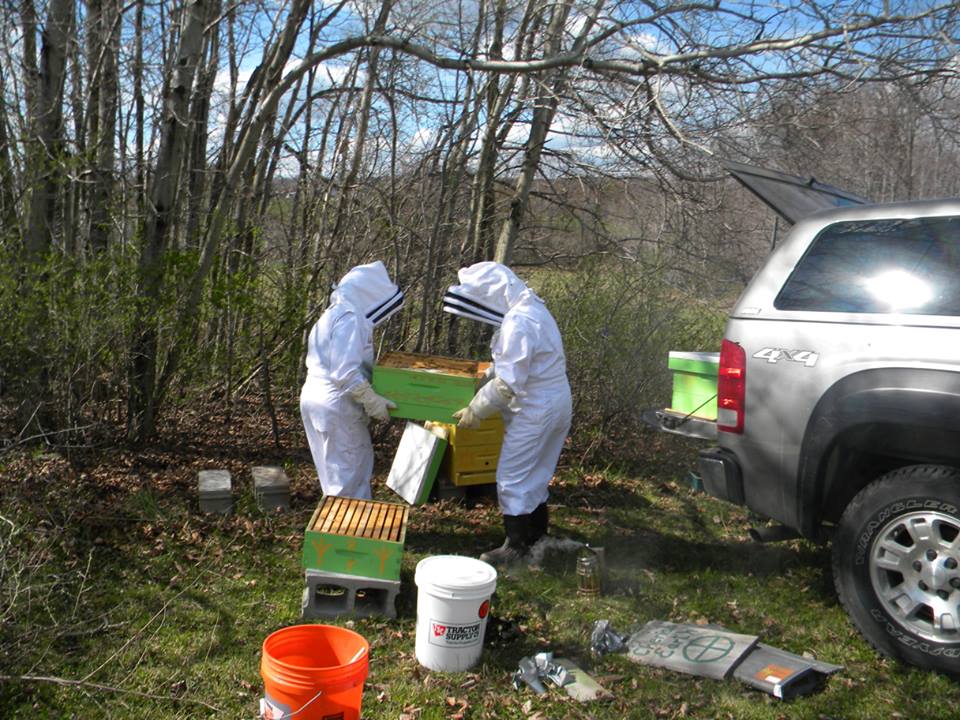
I’ve now been a beekeeper for over a year, and I have begun to deeply resonate with the honeybee. Honeybees are the most amazing, gentle creatures–they make everything from the plants, are extremely hard working, and extremely fascinating.
One of the decisions I made, in my transition from my 3 acre homestead to small-town renting (renting until I find my new land) was to keep my two beehives. Moving two beehives across three states is no easy feat–it requires state inspections, paperwork, and a good friend with a truck willing to drive you there. It also requires overcoming some of your own fears. So in early May, a dear friend and I moved the bees–we move about 50,000 of them in two hives. They were moved to a friend’s farm in PA–an ideal spot, 70 acres, full of clover, flowers, and so much more. I’ve been regularly checking on them, and have been thrilled with their progress in their second year. Most new beekeepers don’t get any honey their first year, and certainly, my hives were no exception. But now in their second year, despite their 450 mile trip to their new home, the hives are strong and the nectar flow is steady. So in this post, I’ll talk a bit about my thoughts after a year of beekeeping and my experiences with the first honey harvest.
Beekeeping Ethically
I’ve become very vigilant about the protection of bees. After seeing the magic of the hive, and visiting other hives who have not survived for various reasons, I’ve begun working to educate others about the bees–knowledge is power. So you can think about this in two ways: the choices that the beekeepers make and the choices that everyone else makes. Let’s start with the beekeepers.
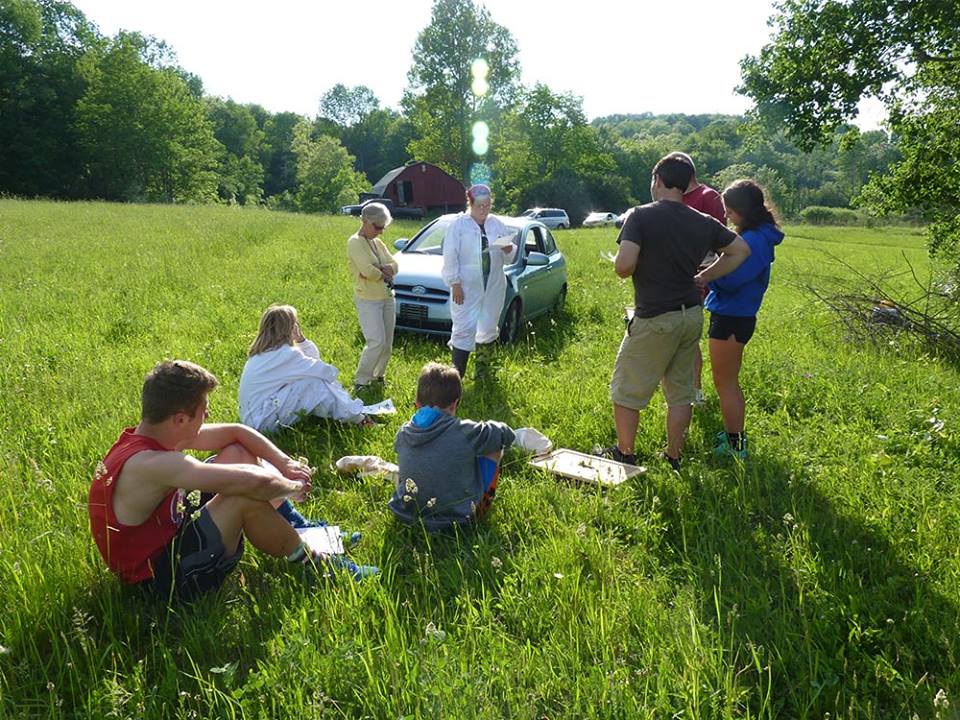
Beekeepers are faced with a lot of choices and the “standard” approach advocated in many books is not the best–its very similar to the choices one faces with other kinds of farming or animal husbandry. You can farm industrially on a large scale with chemicals and destructive practices, or you can farm organically and holistically. You can keep chickens locked up in a building suffering, or you can let them free range to eat bugs. This is all a matter of choice. Beekeeping is the same way–you can engage in industrial beekeeping with plastic foundations (which the bees do not like) and add tons of chemicals to the hive to prevent various diseases and cart them all over the country to pollinate monocrops, or you can work in partnership with the bees using organic approaches and holistic systems design. Similarly, you can choose to harvest ALL the honey from a hive prior to the winter, letting your bees starve and installing a new package of bees in the spring–which brings you a ton of profit. Or, you can harvest only the excess honey and ensure that the bees make it through the winter unharmed. You can choose to kill the queen and put a new one in there the bees are not familiar with at the first sign of trouble (called re-queening) or you can let the bees raise their own queens. The list goes on and on.
I see beekeeping as a partnership–I wouldn’t do anything to them that I wouldn’t do for myself or to my land. This means no plastic in the hive, no chemicals in the hive, and ensuring that the hive health is the top priority (rather than my own desire for honey). I mainly use an approach advocated by Ross Conrad in his book called Natural Beekeeping: Organic Approaches to Modern Apiculture. I use this approach with a few modifications, including letting bees build their own comb for their hive bodies rather than giving them pre-stamped wax foundation–this allows them to build cells to fit their needs rather than build cells to fit a beekeeper’s desires. (This is why I take issue with the “flow hive” that everyone is talking about–its very beekeeper centric and not good for the bees themselves). The way that we treat the bees has energetic outcomes: as I’ve argued elsewhere about food, the better we can treat the land and those animals or insects helping to produce our food, the better we feel when we eat it. But more than that, the bees are such a wonderful blessing to the land–its important we treat them as sacred partners.
Protecting Bees more Broadly
The problems don’t just reside with the beekeeping practices. Bees, and other pollinating insects like Monarch Butterflies, are in serious trouble on a larger scale. Modern land use–from industrialized farming to maintenance of the lawn–are destroying habitats and exposing bees to destructive chemicals. At some point, I’ll break down these practices in more detail, but for now, suffice to say that pesticides (especially neonicatonids), chemicals, GMOs, all the nasty things so many of us who have a spiritual relationship with the land are trying to avoid–are destructive to the bee. When bees go out into the world foraging, they bring back to the hive whatever they pickup. Pesticides and chemicals build up in the hive over time, weakening the hive and eventually leading to a crash. I’ve seen this firsthand–dead hives of dead bees because of “mosquito spraying” in Michigan. Its a horrible sight. To add insult to injury, companies producing and marketing these pesticides have “greenwashing” sites that make it sound like they care about the bees: no Bayer and Monsanto, I’m not buying it.
There are so many things we could be doing differently with regards to our land use. I look at all the places unnecessarily mowed–I look at the swaths of green lawns and the chemicals used. Those could be instead planted with wildflowers and kept without chemicals (or fossil fuels). Keep the dandelions in the ground, plant other kinds of flowers and trees that produce abundance for all–there is a better way! Of course, companies who sell flowers are going to have to stop spraying them with neonicatonoid pesticides first :(. Its going to require a paradigm shift, but believe me, the bees–and everything else–are worth it!
Bees as Alchemists

Even with the challenges that we face regarding land use, beekeeping practices, and bee safety–there is so much to learn from the hive. Bees are truly spagyric alchemists, beginning with materials from plants: netcar, pollen, and resin, and making amazing things: beeswax, propolis, and honey. Bees begin making honey by foraging for nectar from whatever plants are blooming–they drink up the nectar and it goes into a special stomach where they add enzymes to begin to break down the complex sugars into simple ones. They bring this back to the hive, where it is further cured to reduce the water content and eventually capped into honey. One pound of honey requires approximately 100,000 visits to plants on the part of bees.
The wax comes forth literally from their own bodies. They have wax producing glands that create small wax flakes that they use to build comb. Since the wax also derives from honey, it has the same awesome smell. Even in my first year, I was surprised about how much wax I got from the hive–a lot of it was when they built comb somewhere that they shouldn’t have, or had built cross comb that I had to remove. I’m excited to process this wax and make candles, creams, soaps, and salves with it!
Propolis is “bee glue” and is collected by the bees from plants. Its essentially plant resins, and forms a sticky glue where the bees need to seal something up. It has incredible medicinal qualities, including as a contact antimicrobial and great for surface issues, like burns. I took a whole class just on the medicinal uses of propolis–its incredible stuff.
Bees are also masters of sacred geometry, producing a lattice of hexagrams. The Beelore blog has a nice discussion of some of the other geometric connections to bees.
Visiting the Hive
When you up the hive, the first thing that greets you is the amazing smell–its hard to explain what it smells like, but its kind of a combination of propolis, beeswax, honey, and something else–maybe the bees themselves. Its rich. Then you hear the hive– hive has a very low buzzing as the bees go about their work; if you disturb them too much the buzzing increases in volume as the bees buzz louder to sound the alarm. They also buzz louder to fan the hive on a hot day and help regulate the temperature.
I am amazed by how gentle the bees are. If you are a careful beekeeper, you can open up the hive and look at the bees and they are quite calm and happy. I don’t smoke my bees, even though most books suggest to do so–I find it just fires them up and I’d rather work with a calm hive. I still have yet to be stung–and if I’m stung, its not due to aggression on the part of the hive but due to my own stupidity.
My First Honey Harvest
A visit to the two hives yesterday revealed that the hives are doing tremendously well. They have a full hive of honey and brood, and the “supers,” which are the excess honey stores that we can harvest from, are about half full of honey and wax. While much of the honey not yet ready to harvest (it is not yet cured, which is necessary for long-term storage), we were able to harvest a few frames from the early spring nectar flows. These frames were a beautiful, light colored and flavored spring honey consisting mostly of autumn olive and honeysuckle. Here we are at the hives:
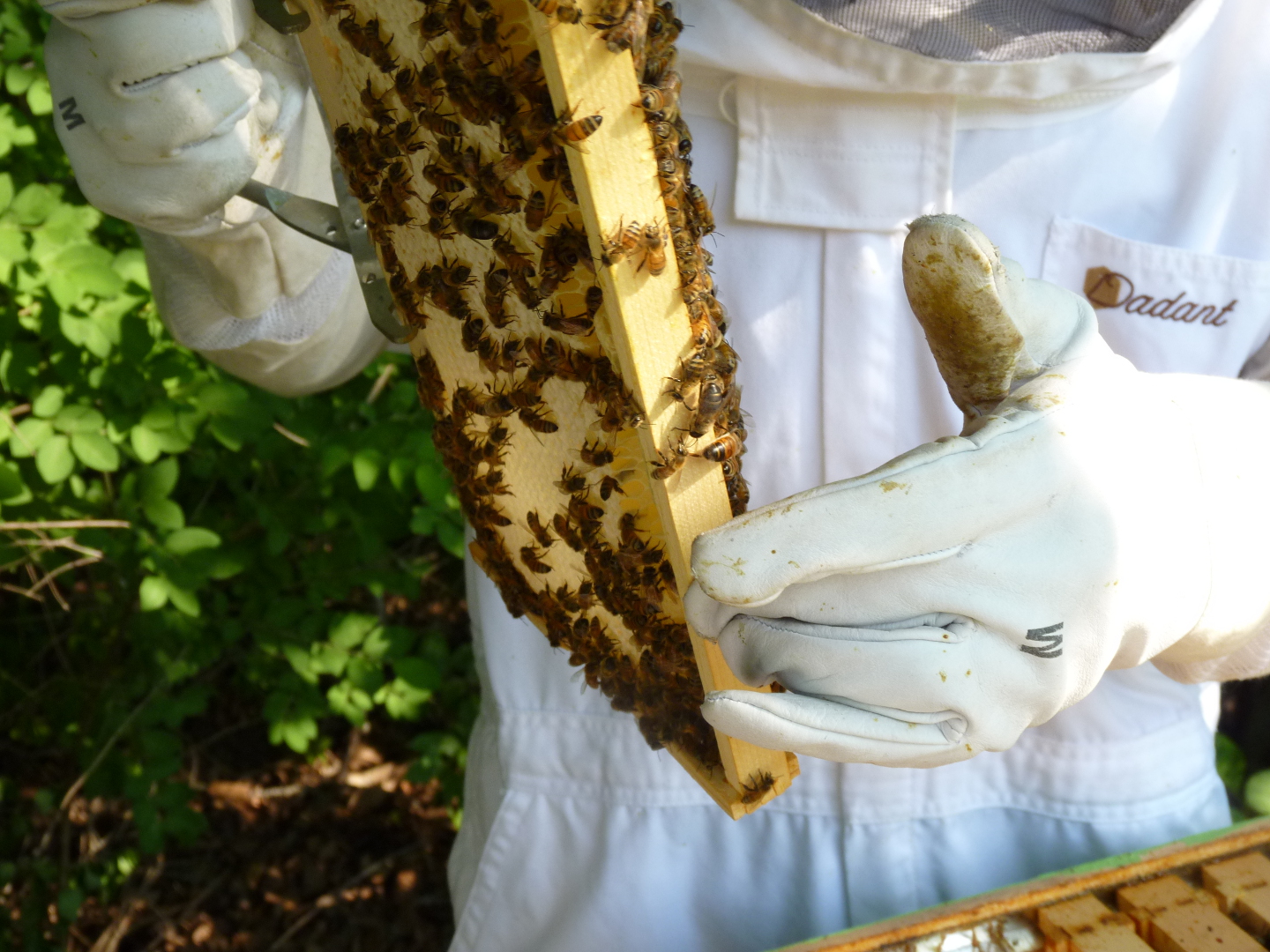

We gently brushed the bees off the comb and replaced it with new frames for them to build.
Straining the Honey
We were left with five beautiful frames of honey, the best we had ever tasted:
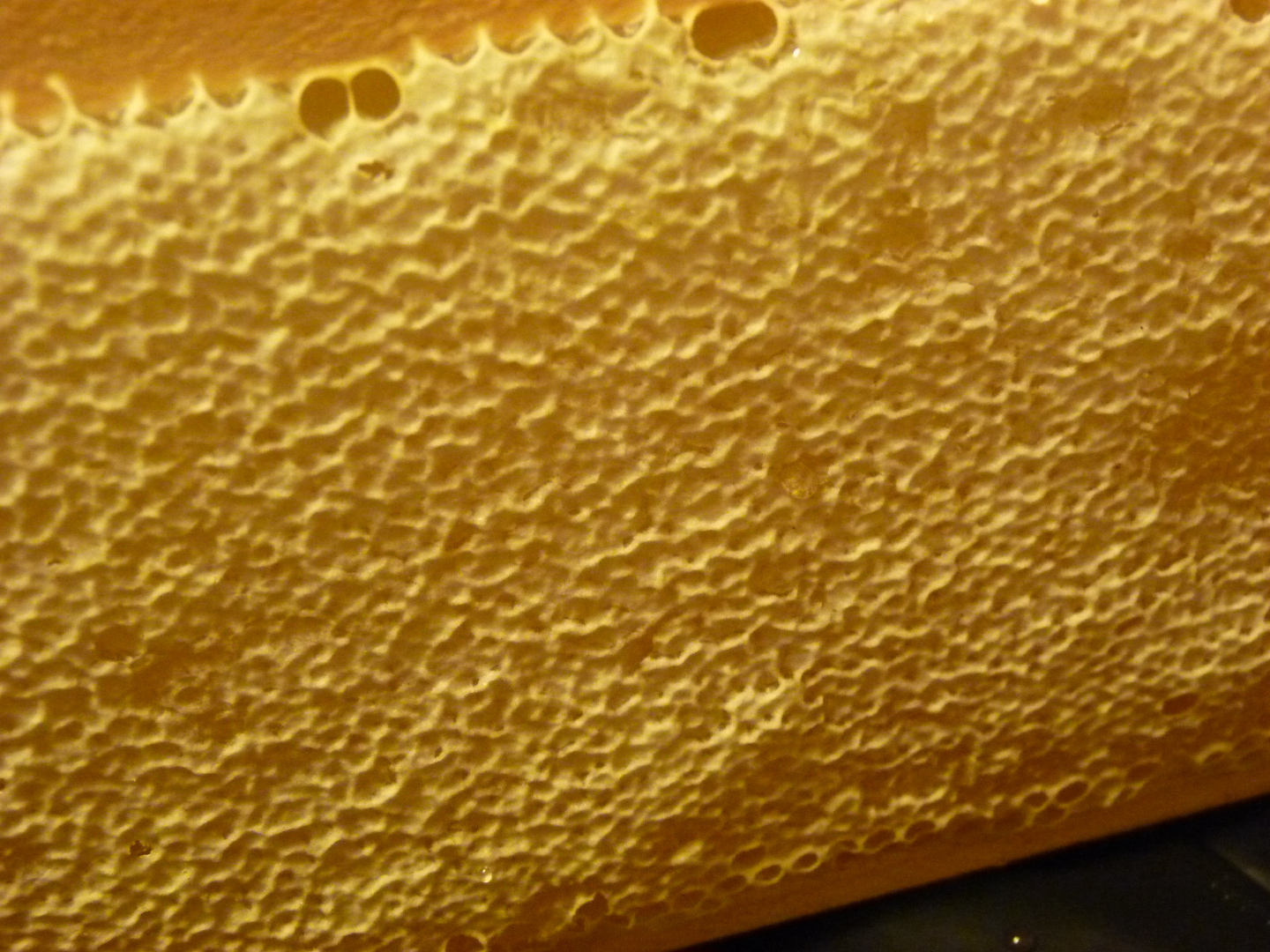
Because honey extractor equipment can run upwards of $700 or more (and depends primarily on plastic foundation we would rather avoid in our hives), we opted for the “crush and strain” approach, which is an old and effective method that yields wax and honey. To do this, we used Joe Lydeck’s instructions on Youtube for a simple crush and strain bucket (the second version in his video). This cost about $30 total and was super easy to construct.
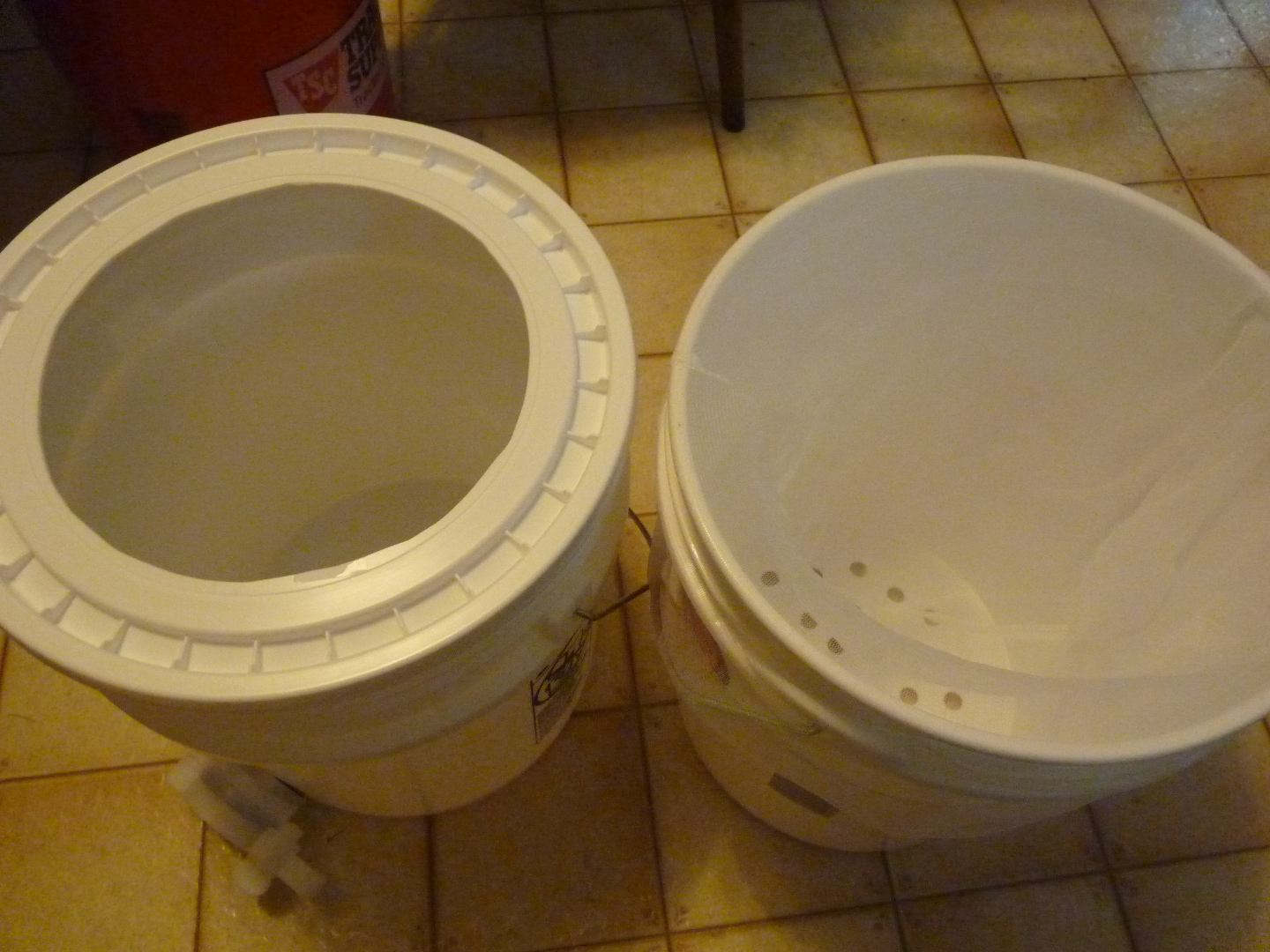
Here we begin by cutting the comb off of the frames. The smell is amazing, the sticky and gooey honey comes right off the comb.
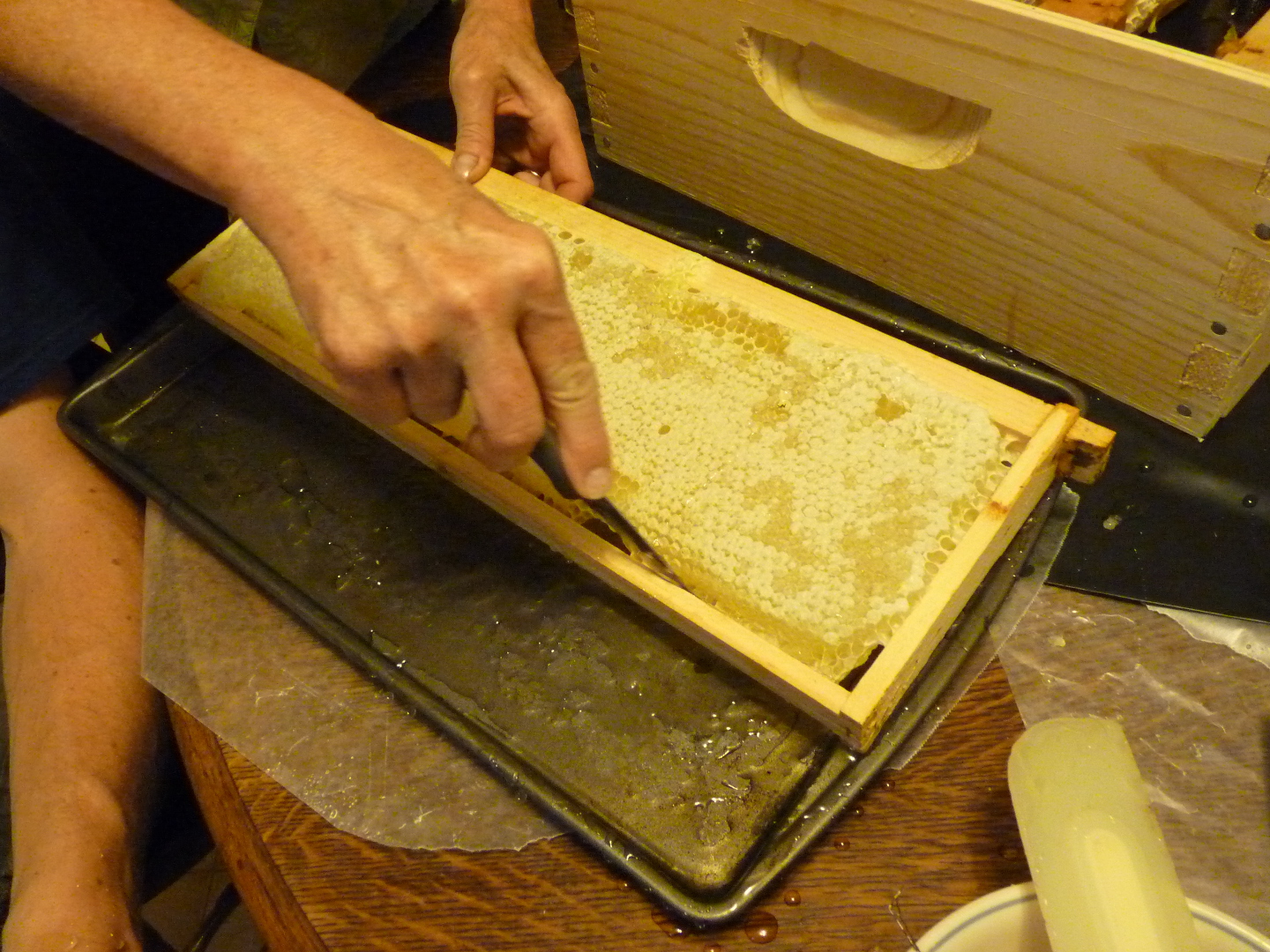
Next, we cut some of it up for comb honey. We also added some comb honey to the jars for our strained honey so that the jar would have a bit of honeycomb in the middle–I saw this kind of presentation in an upscale shop, and thought that we could do it with our own honey.
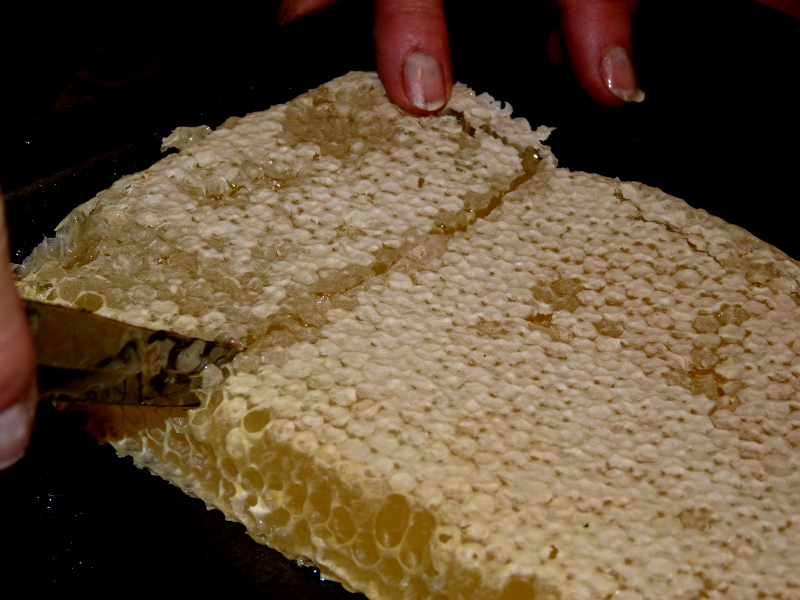
After cutting up the comb, the fun part begins–crushing! You can use different methods for crushing (most use a potato masher, which we couldn’t find). So we opted for crushing it with our clean hands. This was a lot of sticky, gooey fun!
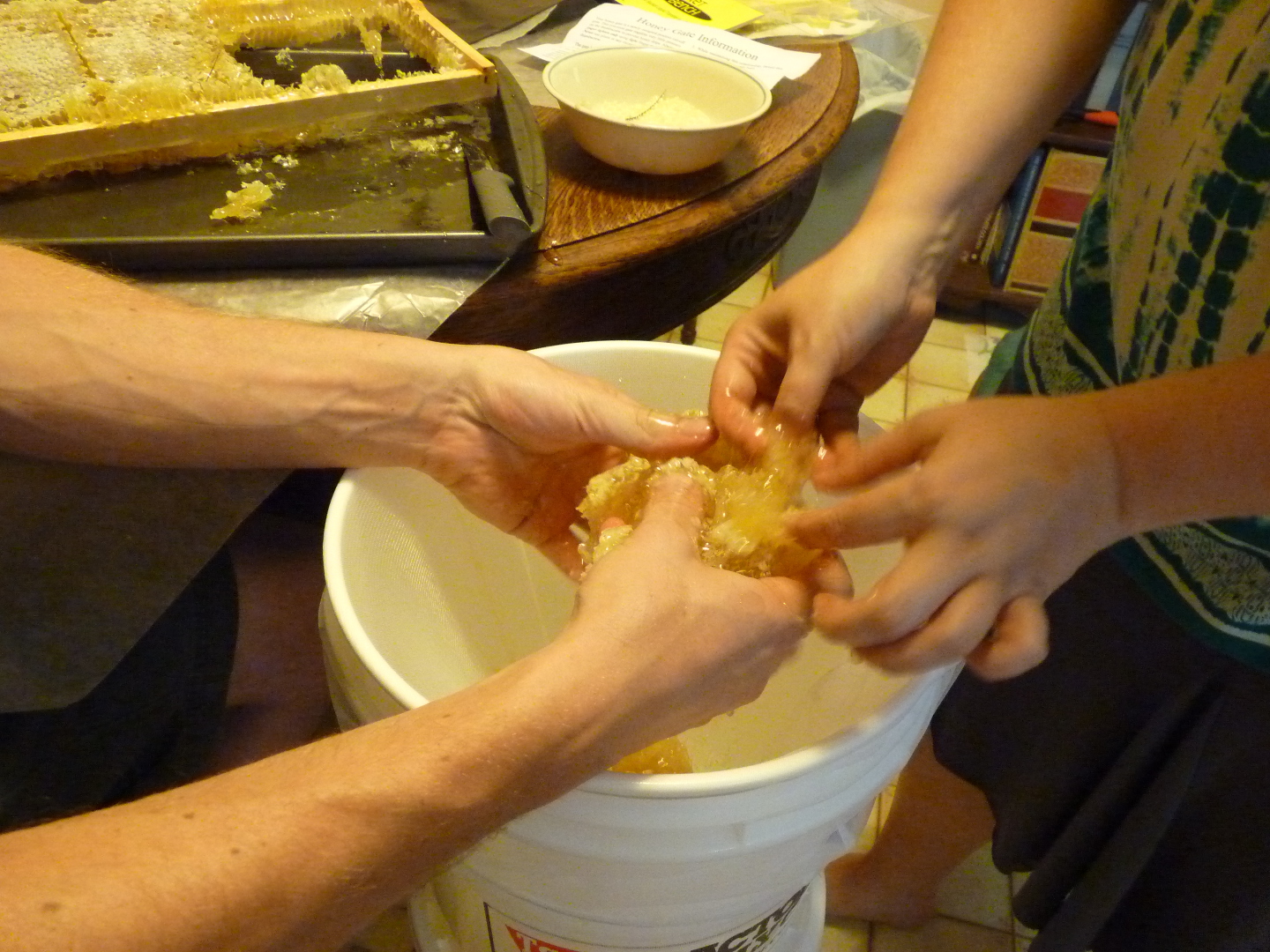
After crushing it up and keeping what comb we wanted, we put the bucket out in the sun for a few hours. This helped warm the honey up so that it would extract from the crushed up comb a bit more easily. After we put it out in the sun for a while, I lifted up the bucket to see what was going on–here is the honey dripping out freely into the lower bottling bucket!

After the wait, we strained the last of the honey and ended up with about 20 lbs of honey–which was incredible given we only had five frames. At this point, we began to bottle. We used sterilized mason jars and other assorted fun jars for the honey. As I mentioned before, we added honeycomb to the center of some jars, and other jars just were straight honey–you can see this in the photo below.

We bottled up the honey and were so pleased with the harvest! I have to make some nice labels for the jars still, but look at all that honey!
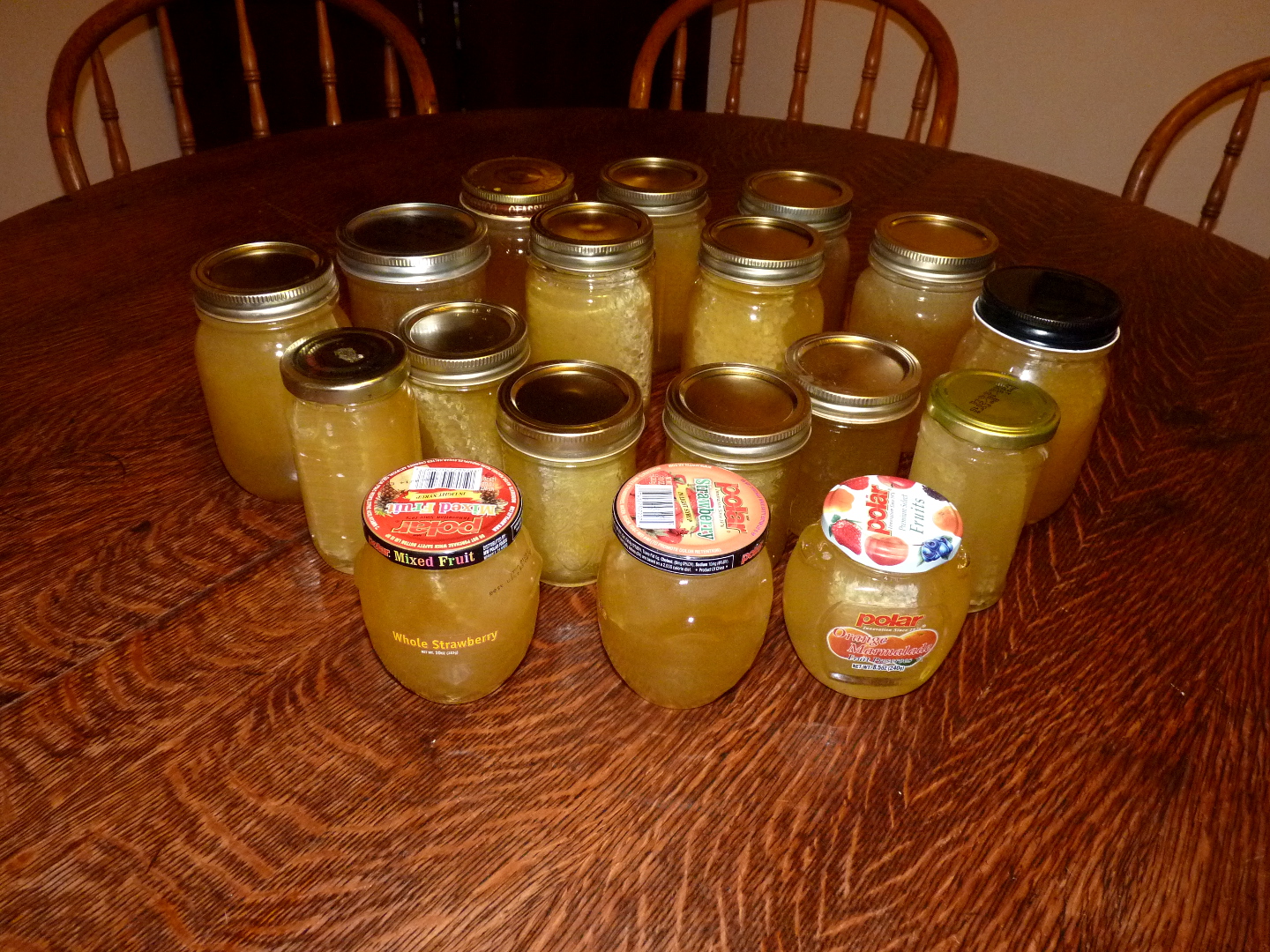
The best part about all of this work is that the equipment needs to be licked clean!
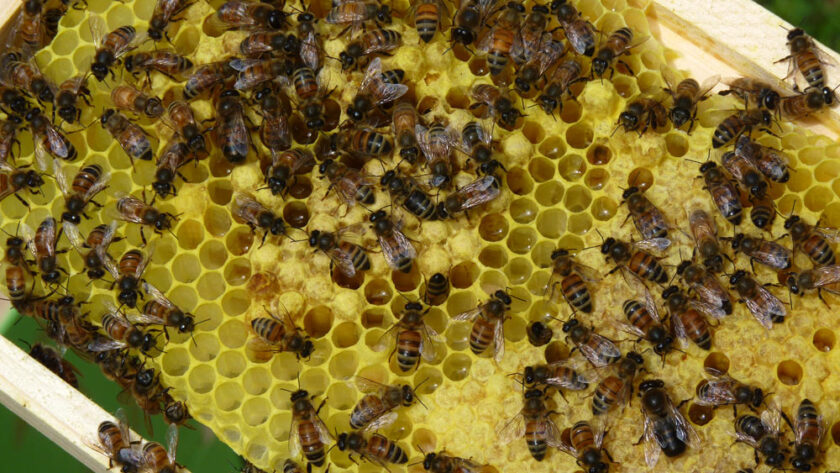
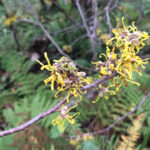


I love this! I love bees. They are precious and sacred. Thank you. I am so happy for you and your bees making the move unscathed. Question: So, do you just use frames that you made? I have kept bees in the past, and intend to again soon. I have the frames that already have stamped beginning for them. I like the look of yours so much better and would rather they make their own. We have a lot of predators here, so we need to build a chain link, cement floored thing – skunks, bears, etc. They are smart critters. But, I love the bees – the working together, the hummm, their beautiful little selves. It is so important to protect them. Fortunately nobody sprays around here. Thank you again for beautiful post. I will refer to it a lot. Great info. I need to watch that video with the strainer thing. I have never seen one. I have never harvested.
Hi! Thanks for the comments!
Now about that semi-foundationless method I’m using: I’m kind of doing a hybrid approach I developed myself, lol.
I’m using standard Langstroth hives, but using them more in a Warre style. So there are frames (which are the wooden slats that go in the hive body) and there is foundation (which is the stamped stuff, plastic or wax).
So basically, what I do is this: For the hive body, I give the bees wax starter strips that I attach to the tops of the frames, then I string two wires through the holes so as they build down, the wax foundation is supported (otherwise, on a hot day, it could slump). Then they build their own comb off of the starter strip. I have found that this works best if you give them foundation between each of the starter strips (or you can get cross-comb). I can take a photo of it when I switch out some of the foundation in the hive next spring (to address pesticide build-up). Some people do this with no starter strip, but it worked better for me this way. You also need to get into the hives and check on their progress every week or so, to make sure you don’t have any cross comb happening. Does that all make sense?
Concerning bears–most people use moving straps and strap their hives to a tree–or they setup an electric fence around the hives. So far, no trouble there.
RE: Strainer – I could not BELIEVE how well the crush and strain method worked. The one downside is that you can’t have the bees reuse the wax comb they built up, but in a good year with a good honey flow, that wouldn’t matter much. But yeah, it worked super well!
Thank you so much! Electric fence doesn’t keep the skunks out. They don’t go for the honey. They like eating the bees, and don’t mind getting stung at all. For them, it’s just sort of like the enjoyable bite of carbonation. Haha. Why don’t the bears get the hives when they climb up to them?
If you had a really low wire, would that keep the skunks out?
The bears do get to the hives if they aren’t strapped down and otherwise protected!
PS: The reason you don’t wear black around a hive is that the bees think you are a bear and attack. 🙂
They can dig pretty far under, that’s why some people suggest burying a footer, and then chain link with a top as well for the bears. It’s pretty secure that way, but a lot of work. Also you can put a chicken coop in there is it’s big enough, for them to go at night. We have a lot of predators for them too – weasels, coyotes, fox, bobcat, mountain lion, etc. So, once we get really settled, we will do all that. Our to do list, as I am sure yours is too, is about 4 notebook pages long. Once 4 more major things are done, that will be a priority. Then I am really going to pick your brain (if you don’t mind)!
Also, don’t wear wool. In a bee class I went to, we were all hanging around the hives and looking in them with no gear on. My husband was about 50 yards away, sitting minding his own business and 4 bees made a “bee line” to him and stung his bearded face. He had on a wool hat. Hahaha, poor guy.
Ahh, I see. I haven’t had such trouble with varmits yet, but I’ll keep this in mind. And thanks for the tip on wool–I had no idea that wool would set them off!
I love the skunks and bears too. It’s just a dance…learning how to live together. The beavers flooded our barn, but we love the beavers, so we re-routed the water using shovels, sticks and stones. It is more work, but we so love all the wildlife. Beaver, elk, deer and mice kill the fruit trees. We fence them now. So it goes. Hence the to do list I mentioned before. 🙂
Lovely piece! You might consider a top bar hive if you want the bees to build their own comb. Christy Hemenway’s “Thinking Beekeeper” is a great place to start with top bar. I’ve been keeping a top bar hive for a year now, I love that the bees get to design their own comb, to their own specs. Christy’s beveled bars prevent cross comb without any need for a strip of foundation wax.
And thanks for the tip about wool! So far, I’ve not been stung either. And I’d rather keep it that way, if possible… 🙂
I had considered a top bar hive, and will probably add one to my hives in future years. What I had found when getting into beekeeping though was that there wasn’t as much info on the top bars, and I couldn’t’ find a beekeeping mentor who had experience with them. Since I was largely teaching myself, I decided to go with what was most available, but still do things my own organic way, haha! The bees do build their comb just fine in a langstroth using the method I described in my comment :). But yes, that’s in the future for sure!
This is beautiful! I loved all the pictures and the information too…now I want to try beekeeping. One more thing to do whenever I’m finally not living in a concrete box. 🙂 You’re very inspiring.
Thanks, BentNeedle! We all have to get out of the concrete boxes. So stifling. Best of luck to you 🙂
It’s always heartening to read about your success with your bees. I very much appreciate the way you put the health and safety of your bees well ahead of your desire to harvest products. Now I admit I have no desire to keep bees myself, although I enjoy seeing various types of them visit my property.
Hi Karen – Yes, I think its critical to put the health, safety, and happiness of the hive over any of your own desires. Given time and patience, all that you want as a beekeeper will be fulfilled! I can’t believe the abundance of the hives this year :).
Wow that was awesome. Such a fascinating process. I dig the term, “sacred partnership.” We are what we eat after all!
Thanks Leeby! It was such a fun process…and there is more honey to come 🙂
Lucky you. Happy harvesting!
[…] you quickly learn as a beekeeper is that the sound of the hive matters. When you first get into a hive, if the hive is in good […]
awesome. You reaped a nice harvest because you have great respect for G-d’s creatures…so He and His bees rewarded you. Its so wonderful to come across folks like you!!
Divash, thanks for the comment! I think that graditude and respect are two of the most important qualities we can have in interacting with anyone, whether it is the forest or each other :).
if you love bees, why do u steal their honey? if u think they are sacred, why dont you let the honey for them? they are sacred, they are in the eco system making it work, dont steal their food then. so simple, dont let the ego run over.
There are a lot of different philosophies out there about humans’ relationship with the rest of the living earth. To me, the most sacred relationships are interconnected ones. We humans depend on the living earth in all of her forms for our basic oxygen, food, shelter, and survival. This is always a give and take. Humans today have forgotten this, and only take. My goal is to bring myself back into healthy balance. And so, yes, the bees are sacred, but I do not “steal” their honey. I work with the bees, and honor them, and in exchange, I take only what is excess that they don’t need. I tend them throughout the year. That’s part of what a sacred relationship is about.